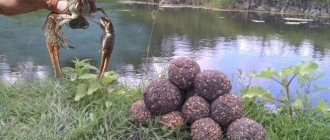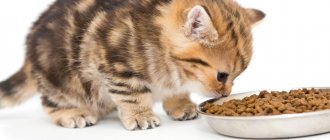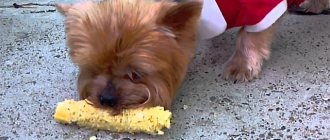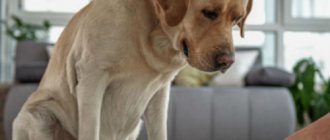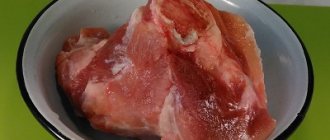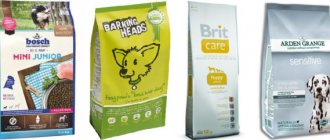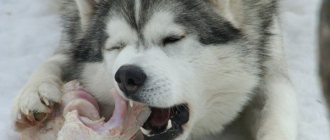The pug breed is distinguished not only by its compact size and original appearance, but also by physiological characteristics (for example, increased sensitivity of the gastrointestinal tract and a tendency to obesity), so a competent approach is important when creating a diet.
Which products are most preferable for this breed, and which, on the contrary, are undesirable? What is the daily food requirement of a pug (adult and puppy) and what should you pay attention to when choosing dry food?
Benefits of natural nutrition
First of all, such nutrition is closest to the natural nutrition of canines. Thanks to it, the pug remains in good muscle tone for a long time and has healthy activity, the coat begins to shine, and the eyes stop watering.
Some representatives of the breed have an increased refinement of taste and simply refuse to eat ready-made food, while natural food always arouses the interest of even the most fastidious dogs.
Inexpensive
When choosing an economical food option, you need to carefully study the composition. Most often, manufacturers replace high-quality ingredients with cheap fillers and thereby reduce the price. The situation with new Russian manufacturers is a different case. It is among them that you can find inexpensive food without dangerous additives.
For example, feed from the Grand Dog , produced in the Krasnodar region. According to the stated composition, the diet corresponds to holistic feeds, and at the same time has an economy class price level. Due to the lack of aromatic additives, the food is not always attractive to picky dogs, which is the only significant disadvantage.
A similar situation is with another Russian manufacturer – Zoomenu .
Another good food with a good price and good composition is Organix . The only downside is the presence of corn. However, if the pug is not prone to allergies, this food is perfect.
Disadvantages of homemade food
A significant drawback is the need to balance the components so that the body does not create an excess of one substance with a deficiency of another.
So, for example, when feeding exclusively meat tenderloin, an increase in phosphorus in the blood is inevitable, while calcium levels decrease. And hence problems with bones, joints, and fur. It is best if the initial diet is compiled by a nutritionist, based on laboratory blood tests of a particular individual.
Another disadvantage of this feeding is the time spent preparing food. Meat, in most cases, does not require heat treatment. However, washing, cutting, and arranging the bowl takes time, and this time is much longer than what is required when pouring ready-made food.
Well, perhaps the last disadvantage is the price. When feeding high-quality natural food, its cost is comparable to the level of good super premium food.
Industrial food for the treatment of dogs
Many manufacturers produce food enriched with special substances that can improve the condition of the pet. Thus, by giving your dog a certain food during illness, you can avoid taking additional medications. Some types of drying are used to prevent the development of pathologies.
Pug diseases and their symptoms: how to understand what happened to your pet
They produce food for treatment:
- diseases of the musculoskeletal system;
- obesity;
- hair problems;
- urolithiasis;
- for diabetics;
- problems with the gastrointestinal tract;
- strengthening blood vessels;
- diseases of internal organs (heart, liver).
Video - Hypoallergenic food for pugs
Adult pet diet
As a pug ages, its needs change. At first, the puppies' diet consisted of at least 50% of the daily intake of milk and fermented milk products. From 3 months this place is occupied by meat.
After a year
While the puppy is growing, it requires food with a high content of proteins and fats. Dogs aged one year and older no longer have such a high need for energy from food. Therefore, it is necessary to provide more dietary meat to prevent excess weight gain.
You should also exclude or minimize high-calorie flour products. This increases the load on the joints. Experts recommend switching to the Barf nutrition system, the principle of which is to eat lean meat, avoid cereals and any salts.
We use the trial method
Despite the many advantages of natural food, you will not be able to independently determine the quantitative set of useful microelements and vitamins. You won’t even know what you can replace them with. Consequently, a diet made from natural products will always be only approximately balanced. An excellent way out of the situation is ready-made dry food, where specialists have already calculated everything.
The amount of proteins, fats, carbohydrates and other components is indicated on the packaging, recommendations are given on how to feed the pug correctly, that is, how much food should be given at one time depending on its weight. All you have to do is follow the proposed scheme. However, not all so simple.
The fact is that the pug is a breed prone to allergies, obesity, and its digestive system is not very stable. Therefore, in practice, until you find the food that is suitable for your pet, you may have to try more than one brand. We advise you to choose ready-made meals of at least premium class.
For example, the well-known Royal Canin can attract many pug owners with its relatively low cost. It is made on a plant basis with the addition of chicken by-products. But whether it is suitable for your pug is a moot point. To determine this, we recommend buying some food and seeing how the dog and his body react to such food. This advice applies to any brand and manufacturer. This food comes in the following types:
- Brit (hypoallergenic, with lamb and rice);
- Organix (for sensitive dogs);
- Acana (for puppies, lactating and pregnant bitches);
- Bosh (for older dogs);
- Orijen (due to its high protein content, suitable for very active pugs and puppy dogs);
- Wolfsblut (does not cause allergies);
- Go Natural Holistic (grain-free, suitable for dogs of all ages);
- Eukanuba Adult (high quality protein sources and low fiber content);
- First Mate (grain-free fish and potato based puppy diet);
- Arden Grange (high meat content).
For this poro, the American food Canidae All Life Stages, which does not contain too much protein, may be suitable. Or Hill's Science Plan, which is produced in the Netherlands. Its advantage is the reduced amount of proteins, and its convenience is the small size of the granules.
The assortment is quite wide, it remains to add that it is not recommended to give wet food. A special canned meat mixture mixed with crushed biscuits is recommended to be given as a treat. These products contain the required amount of nutrients and minerals.
How many times a day is best?
Just as with dry food, in relation to pugs, fractional feeding is most useful. At least 3 times a day.
- The morning diet , as a rule, consists of cottage cheese and fermented milk products.
- At lunch, the pug should receive 50% of the total daily portion. Meat raw or lightly scalded. Additionally, chopped vegetables and a quail egg are given twice a week. Bones only when raw.
- Dinner. By-products require heat treatment. It is better to postpone them for the evening. No more than 20% of the diet should be cereal.
Between main feedings, small snacks with low-calorie foods are allowed. You can give apples and other fruits between breakfast and lunch, and meat tails or chewing bones before dinner.
Breed lines, rating
Interesting!
The nutrient requirements of dogs
of different breeds differ in composition and quantity . This is determined by size, characteristics , energy needs , structure of the muzzle, and shape of the jaws.
To decide on the type of food for your pug, focus on the following parameters:
- Health status
. If your pet is healthy, use the diet for daily feeding. The veterinarian will give advice on feeding a dog that is sick or has physiological problems. - Age.
Almost all brands produce food for puppies, teenagers, adults and older dogs. This information is on the packaging. - Lifestyle.
Pugs lead an active lifestyle in the first year, then they like to lie down and sleep. But everything is individual. Choose breed food that matches your pet’s temperament: Activ or Normal. Light (light) is suitable for overweight animals.
The Royal Canin company has developed a series of dry food for pugs, which takes into account the structural features of the dog’s head and jaws: trefoil-shaped pieces are easy to grasp with a flat muzzle. Specialized food has been developed for adult dogs and puppies: Royal Canin-Pug Adult, Royal Canin-Pug Junior.
Pearl barley and other cereals
Dogs are carnivores and, unlike humans, their source of energy is proteins, not carbohydrates. Porridge is added to make your pet feel full as quickly as possible.
It is worth considering the fact that of all cereals, only rice and partly buckwheat are fully digestible by canines. The rest of the cereals go through the body in transit, without bringing any benefit. It is not advisable to eat them. And some cereals, such as semolina, also threaten obesity.
Rice and buckwheat can be given either individually or mixed. Under no circumstances should you cook porridge in meat broth; such a diet can easily disrupt the pancreas. But adding vegetables such as pumpkin, zucchini, and squash will, on the contrary, improve the functioning of the gastrointestinal tract due to the content of plant fibers.
Natural food
You can create the right menu yourself by first familiarizing yourself with the list of foods allowed for dogs.
Required for admission are:
- lean meats;
- sea fish;
- skim cheese;
- offal: liver, heart, kidneys, lung, liver;
- dishes with vegetables, seasoned with vegetable oil.
This is interesting: “>What types of cabbage can be given to dogs
Expert opinion
Anna Abramenko
An avid dog lover. Experience in veterinary medicine since 2009.
Ask a Question
It is prohibited to mix meat with other foods. It should be cut into large pieces.
Among the cereals that are beneficial for dogs are rice and buckwheat.
List of foods that can be given
The basis of the diet is chicken backs, turkey necks, and beef with tendons. Liver, light, is best simmered until done, with a little garlic added to naturally enhance the flavor.
Tripe is a very useful nutritional element. It is given raw, unrefined. Despite the specific smell, it has undeniable benefits for the dog due to its high enzyme content. Beef udder is very high in calories and is not recommended to be fed more than once a week.
In addition to meat and offal, the daily portion must contain vegetables and herbs. They are most beneficial when crushed and raw.
Daily consumption of cottage cheese and fermented milk products will help maintain the correct balance of calcium and phosphorus in the body and improve the functioning of the gastrointestinal tract.
What vitamins are needed?
Vitamins that a pug needs for good health:
- vitamin A . Necessary for the good development of pug puppies, including the period of mating, pregnancy, and lactation. It is found in tomatoes, greens, carrots, liver, milk, fish oil and egg yolk;
- vitamin B. To keep your pug's skin and muscles healthy and strong, this vitamin is needed. It is found in liver, brewer's yeast, dairy products and greens;
- vitamin C . Prevents diseases of the gums and joints, improves the body's immune system. It is found in fruits and vegetables;
- vitamin D. Necessary for a growing dog - it prevents rickets, strengthens bones;
- vitamin E. It is a reproduction vitamin and is needed by pugs during periods of mating and pregnancy. Contained in beets, carrots, greens and cereals.
What can't you eat?
- Like dogs of other breeds, pugs are strictly prohibited from eating natural chocolate. Even a small bite of this treat can result in a painful mixture for your pet.
- Caution should be exercised when giving other sweet treats as dogs, like humans, are prone to diabetes.
- Excessive consumption of baked goods will certainly lead to overweight in pugs.
- River fish, like pork, when raw, carries the risk of infection with parasites.
- Tomatoes often cause allergic reactions and stomach upset in pugs.
- Cow's milk also often leads to stomach upset.
- Walnuts, pistachios, and almonds are not food specific to dogs and put a lot of stress on the pancreas.
- Citrus fruits are almost always an allergen.
- Frequent consumption of bananas leads to rapid weight gain.
What should you not feed your pug?
Products that can cause irreparable damage to a dog’s health should be strictly excluded from its diet. Many of them lead to excess weight, provoke allergies, and the development of diseases of the dog’s gastrointestinal tract and endocrine system.
Video - What are pugs allergic to?
Prohibited products include:
- sweets and flour products;
- sausages, frankfurters, smoked meats;
- sugar substitutes;
- mushrooms;
- corn and peas;
Not all foods are suitable for feeding dogs
- semolina;
- grape;
- oranges;
- raisin;
- potato.
Some dog owners do not know or do not want to understand that their pets are not omnivores, and feed them inappropriate and sometimes harmful foods. This approach to feeding a dog sooner or later leads to disastrous health consequences, and in advanced cases can be fatal. You can read more about what you should not feed dogs in our separate article.
Menu for pregnant and lactating women
During pregnancy, increased stress is placed on the bitch’s body; not only her health, but also that of future puppies, depends on nutrition during this period. Veterinarians and breeders agree that you should not overfeed your dog during this period. It is better to exclude cereals from your diet and replace them with fresh vegetables.
Often, due to toxicosis, the dog refuses to eat. In case of pregnancy, fasting is unacceptable, so it makes sense to offer the expectant mother a piece that is more appetizing to her. The number of feedings increases from 3 to 6 times a day, but it is better to give small portions themselves.
During this period, you should avoid fatty meats and raw fish. But if a dog wants to try a previously forbidden citrus fruit, it’s quite possible to pamper it with a small amount. The main principle of this period is more vegetables, less carbohydrates and only easily digestible white meat.
Features of feeding
In order for your pet to feel great, it is necessary to make its food healthy and balanced. Pugs have a very small stomach capacity, so they need solid food. Liquid and porridge-like food not only fails to saturate the body, but also has a bad effect on the entire digestive system.
Meat is an essential product in a dog’s diet.
The amount of food must be selected individually for each pet. General calculations are not always suitable for every dog. Pugs are prone to obesity and should not be overfed. If your pet shows obvious signs of excess weight, then the portion he receives daily is too large and needs to be urgently reduced.
Food for pugs should not be too hot and not too cold. Ideally, the food on a dog's plate is at room temperature. You should not add salt to your pug's food. Occasionally you can add a little salt to the stewed vegetables.
Meat and fish are given only in their pure form, without any additives
When feeding naturally, you need to take into account that the dog is a carnivore and the majority of its diet should consist of meat. Meat and fish products normally account for 70% of the daily diet.
Reference! It is not advisable to combine meat and dairy products in one feeding. If your pet ate meat in the morning, then kefir should be given in the evening.
What to do if you don’t eat for the second day?
It often happens that a pug skillfully manipulates its owners, not touching the food and waiting for a more tasty morsel.
If the dog does not eat for 2 days, but drinks water, is active, goes to the toilet well, does not have a fever or pale mucous membranes, there is no need to worry. Fasting days will only benefit your pet.
But if any of the symptoms described above appear in your anamnesis, you must urgently contact a veterinary clinic to establish an accurate diagnosis.
How to avoid obesity in pugs?
Obesity is one of the most common problems in this breed. Pugs are great lovers of food, and owners often cannot refuse when they see their eyes asking for goodies. You can read more about obesity in dogs in our separate article. To avoid a problem that can greatly harm your pet’s health, you must strictly follow all the rules for feeding dogs:
- do not give more food than prescribed;
- remove the bowl after each feeding, even if the dog has not eaten the entire portion;
Obesity shortens the lifespan of pugs
- do not allow your pet to beg at the table;
- Do not feed your dog human food.
If the dog has gained excess weight, you should slightly reduce the daily portion and, if possible, increase the duration of walks.
Owner reviews
“This year we became the happy owners of a beautiful pug girl. However, they were soon faced with what became a whole problem of feeding her.
We tried a lot of foods, from the simplest to the holistic ones, but at best the interest in them lasted no more than a week. I learned about the Barf system from other owners. And lo and behold! It turned out that our princess really loves to eat! Now only straight."
Olga Volkova, owner.
“But natural food didn’t suit us; we’re allergic to everything. Only specialized dry food is suitable.”
Natalya Zubova, owner.
“We bought a male pug and started attending exhibitions from the age of 4 months. Experts noted dull fur and excess weight. It was not possible to achieve the desired effect with the finished food. Therefore, after consulting with the breeder, it was decided to switch to natural nutrition.
Mike was enthusiastic about the new menu, and the results were not long in coming! Literally a month later, the fur began to shine, excess weight disappeared, and at the same time, movements in the ring improved.”
Oleg Yushkov, owner and handler.
Veterinarian recommendations
“When choosing food for a pug, it is necessary to take into account the brachycephalic structure of the skull. The pug has a large round head with a rather short square muzzle and a tight bite.
The characteristic shape of the jaw and very thick lips do not allow pugs to easily grab food, as a result of which they often swallow kibble without chewing it. To avoid food getting into the respiratory tract, it is recommended to avoid using too small granules in the food.”
Konstantin Volsky, veterinarian.
“Skin with natural folds. The Pug's short coat accentuates the natural folds of its skin, especially around the muzzle. Moisture accumulates in folds, and for this reason they can become a source of dermatological problems. Regularly cleaning the folds and choosing dry diets helps reduce this risk.”
Vadim Kuznetsov, veterinarian.
Basic principles
The pug's digestive system is very delicate and sensitive. Although small dogs are capable of eating anything, you should not indulge their whims. You cannot feed your pet all foods in a row. This approach will lead to the development of serious illnesses, obesity and even the death of your four-legged friend.
One of the principles of proper nutrition is regimen. Feeding at strictly prescribed times and portion sizes adjusted according to age will help avoid health problems.
A bowl, even with half-eaten food, must be removed immediately after eating. If the dog begs for more, you will have to control yourself and not give in to your pet’s whims. A double portion will only do harm.
To avoid harming the pug's delicate digestive system, it is fed warm, solid food. Food that is too liquid can cause stomach upset. Dog owners need to ensure that there is always a bowl of clean (not tap) water and milk where the dog is fed.
Canine substitute
Bitches' milk replacers are designed for full feeding or partial supplementary feeding. It can be offered from birth to weaning . Usually puppies switch to expanded nutrition at the age of 1 month.
The mixture, specially developed by specialists, is as close as possible to mother’s milk in composition and properties. The substitute prevents gastrointestinal upset, ensures optimal growth and strengthens the immune system.
One of the most popular substitutes is the mixture from Royal Canin . The peculiarity of the product is the presence of docosahexaenoic acid. It is essential for the formation of the dog’s nervous system and retina.
Beaphar puppy milk formula is packaged in a simple plastic jar and comes with a measuring spoon. It is intended for puppies up to 35 days of age and as a dietary supplement for pregnant and lactating individuals. Enriched with vitamins and minerals.
Brit Care Puppy formula does not contain palm oil or starch. It is ideal for pregnant, lactating and weakened animals. Enriched with probiotics for comfortable digestion.
Criterias of choice
Choosing food for a pet is a complex and responsible task that needs to be approached with the utmost seriousness. There are several characteristics to consider when purchasing and acquiring food.
Your dog's health is important. If your four-legged pet is completely healthy, then you can feed it with formulations suitable for daily nutrition
On the other hand, if a pug is allergic or has other physiological abnormalities, then it is important to consult with a veterinarian before purchasing food, who will help you choose the type of food based on the individual characteristics of the animal.
The second feature to consider is the age of your pet. So, there are special formulations that are intended only for small puppies, or food that is given to adult dogs. Usually information about which food can be given at what age is indicated on the packaging. An equally important characteristic is your dog’s lifestyle, level of activity and energy.

